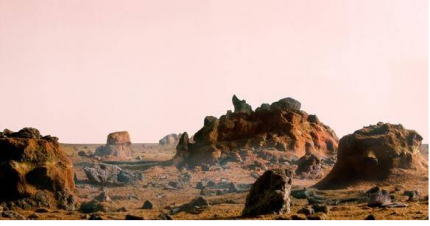Little landscapes for the BIG screen
We often go to the movies to escape our reality. Conversely, many filmmakers try to make a ‘recognizable reality’[i]. There are more than a few takeaways from the modeling techniques of the film industry, and many that could be compelling entries in the designer’s playbook.
1. Choose materials with purpose. It is advised that suitable materials are chosen for construction and used judiciously. Effects teams do tests first, so too should designers. Great things to look for in tests include desired tolerance, stability (or lack thereof) and visual effect. Materials test were essential to the hydraulic models and moving landscapes of Inception.
Artist Matthew Albanese series ‘strange worlds’
shows us that appropriate material choices don’t have to be standard.
http://twistedsifter.com/2010/02/how-to-make-small-scale-super-realistic-model-landscapes/
Paprika Mars: Made out of 12 pounds paprika, cinnamon, nutmeg, ichili powder and charcoal. Mars was Matthew’s first model he made in this series
2. Disparate parts can in fact become a meaningful and cohesive whole. For example Gotham City in Batman Begins looks like an everyday city with a pulse, with streets and with a familiar boldness. A scene can be made from a stitching of physical models, painting/imagery and digital layers. Designers can allow the viewers brain to do some of the work and fill in the gaps of a model. The miniature model that was used in many shots was mapped from photographs of Chicago but contained elements from many urban cores including Chicago but reaching as far as London. On screen, however, it reads as a layered and rich cultural center, a modern and real city.
It’s also great to think of photography as a mapping with a personal and experiential qualities that aren’t always present in a Google Earth or similar aerial.
Double Negative (www.dneg.com) a renowned effects studio gives behind the scene looks at their models and processes for some very popular films.
Batman Begins:
http://www.fxguide.com/featured/double_negative_breaks_down_batman_begins/
Inception:
http://www.fxguide.com/featured/inception/
3. Relish in serendipity and oddities. Commonplace to the creatives in every field is the knowledge that a plan is great but it can only be indicative not definitive or absolute. Something unexpected is bound to happen – use it as a positive. Some accidents are happy accidents and can be informative pauses, useful irregularities and a chance to rethink an original prompt. Other times unplanned happenings should just be embraced as a lesson. Some mistakes are opportunities to recognize a failure and as blunt as it may seem, start again.
[i] Magid, Ron. “American Cinematographer: Batman Begins.” ASC: The American Society of Cinematographers. N.p., n.d. Web. 9 Feb. 2013. <http://www.theasc.com/magazine/june05/batman/page6.html

